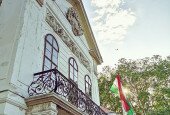Széchenyi Palace, Nagycenk
The residence of the Széchenyi family in Cenk, as a national memorial monument of Hungary, commemorates the life and work of István Széchenyi and the family working for the development of Hungary.
In Nagycenk you can find the central main building of today's palace ("Old Palace") and the ornate French garden that was built in Baroque style in the 1750s during the time of General Antal Széchényi and his wife Zsuzsanna Barkóczy.
After the death of Antal Széchényi's widow, Ferenc Széchényi took over the estate centre and rebuilt it in Classicist style, and he also created the English park around it. Here he stored his collection of valuable books, manuscripts, minerals, and a part of his medal and map collection, which he offered for the benefit of today's Hungarian National Museum and the National Széchényi Library in 1802. In 1820 István Széchenyi inherited the palace and extended the building complex with side wings connected to the central building at right-angles (the eastern Riding School and the western Széchenyi Wing).
In the west wing the first bathroom Hungary with a circular pool that is suitable for having a shower, and an English-style flush toilet were made, and the palace garden was given gas lighting.
During the time of his older son, Béla Széchenyi the English park was completed with many plant rarities from his expeditions in Central and Eastern Asia.
After World War II, the abandoned palace nearly fell into despair its furnishings were dispersed. After the completion of the renovation works that were going on for more than two decades, the Széchenyi István Memorial Museum was opened on 21. September 1973, in the middle of the building complex, the so-called “Old Palace”. Still, renovations were not fully completed in the palace. The renewal of the eastern wing of the palace complex and the former stables followed and then the exhibition area was further expanded in 1985, when the Széchenyi wing was renovated.
From November 2014, the Eszterháza Cultural, Research and Festival Centre took over the management of the Széchenyi István Memorial Museum. The ground-floor halls of the exhibition present the history, ascension and the prominent persons of the Széchényi family as well as the life of István Széchenyi. The interiors, furbished with furniture, paintings and documents of the period evoke the atmosphere of a 19th-century palace. Baroque stairs lead to the first floor, where several documents, models and miniatures invite you to learn about the practical works of István Széchenyi. The palace, the palace park and the Linden Alley have all been part of the Fertő Area World Heritage Site since 2001. The palace park and the Linden Alley are among the historical gardens of Hungary and they are also a nature protection area.
During the reconstruction work between 2020 and 2023, the Old Castle, the Széchenyi Wing, the Flower House, the Pandurhouse and the Castle Park were also reconstructed and the exhibition presenting István Széchenyi as a statesman and private person was renewed.
From 1st October 2025 the Széchenyi Castle can be from Tuesday to Sunday between 10 a.m and 5 p.m.(Ticket office closes at 4:30 p.m.)
Ticket information HERE!



